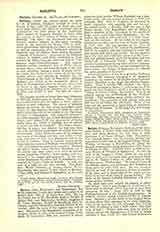

Barlings, Abbey of, located about six miles E.N.E. of Lincoln, England, founded in 1154 in honor of Our Lady by Ralph de Haye who had given some lands to the Abbot of Newhouse (also in Lincolnshire, the first abbey of the Norbertine Order erected in England, founded in 1143) witn the request to send a colony of White Canons to Barlings. The abbey was afterwards removed to Oxeney, another locality in the same township, where it was dissolved by Henry VIII in 1537. Much information concerning the Abbey of Barlings, as well as concerning other Norbertine abbeys in England, may be derived from Bishop Redman’s “Register of Visitations”, preserved in the Bodleian Library at Oxford, and lately published in three volumes by Abbot Gasquet under the title of “Coliectanea Anglo-Premonstratensia”. This register contains various documents, lists of White Canons in each abbey, notes and remarks made at the time of each visitation, during a period of about thirty-five years that Redman was visitor of all the Norbertine abbeys and priories in England for the Abbot-General of the Order of Premontre. Richard Redman was Abbot of the Norbertine Abbey of Ship in Westmoreland when he became visitor, and he acted in the same capacity when he successively became Bishop of St. Asaph in 1472, of Exeter in 1495, and of Ely in 1501. He died August 24, 1505.
This register records no fewer than nine visitations of Barlings Abbey made by Redman. The various lists found therein give the names of about eighteen canons at each visitation. The names of nineteen abbots are known; the first abbot was called Adam (1154), the last Matthew Mackarel (1532-37) who is said to have been one of the leaders of the Pilgrimage of Grace in Lincolnshire. The supposed complicity of Abbot Mackarel, like that of other heads of religious houses, gave Henry VIII the opportunity of laying hands upon the Abbey of Barlings and of placing it under the law of attainder. The abbey church, 300 feet in length, was defaced, the lead torn from the roofs, and melted down under the special direction of Cromwell. Abbot Mackarel, some of his religious, and many of the clergy and laity were taken to Lincoln, and some of these were afterwards sent to the Tower in London. Those in Lincoln, among whom there were four canons of Barlings, were tried March 6, 1537, and ordered for immediate execution. Towards the end of March, Abbot Matthew Mackarel, one of his canons and some others were tried in London before Chancellor Oudeley, found guilty, and condemned to be hanged and quartered. At the time of the dissolution the abbey and its possessions were granted to Charles, Duke of Suffolk. An arch and part of a wall are the only remains. The Right Rev. Martin Geudens, of Corpus Christi Priory, Manchester, was named Titular Abbot of Barlings, May 7, 1898, and blessed September 17, of the same year.
MARTIN GEUDENS

